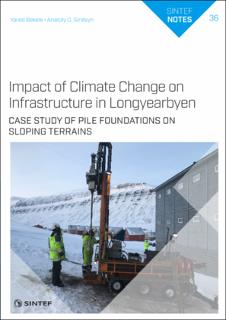| dc.description.abstract | The effect of climate change on existing infrastructure in Longyearbyen, Svalbard is investigated in this study. Climate data recordings show that, over the past couple of years, record-breaking temperature and precipitations measurements are observed in this area. It is anticipated that this will pose a serious threat to existing infrastructure and will impose additional challenges for new developments. Adaptations of existing and future infrastructure to changes in climate for safety and serviceability is of paramount importance. The current study aims to contribute towards this initiative.
The particular focus of the study was slopes and buildings supported on sloping terrains in Longyearbyen. Changes in ground temperature are investigated based on existing temperature data and forecasts. The ground thermal regime is then used to evaluate the stability of representative slopes in the study area. The capacity of single piles on a slope is also investigated by considering various factors such as slope angle, location of pile on slope, pile material and geometry. The following findings are observed from the investigation:
The projected climate data show that temperatures will keep rising in Svalbard. Based on the analytical and numerical studies performed for the projected temperature data, it is observed that the active layer thickness will increase up to 2 m or more, depending on the thermal properties of the soil. The increase in ground temperatures also results in the warming of the permafrost underneath the active layer. The stability of slopes and the bearing capacity of existing infrastructure foundations is expected to be significantly affected by these changes.
Slope stability evaluations were performed for a representative slope in the study area by considering changing active layer thicknesses according to the projected ground temperature regime. The factor of safety against slope failure decreases with increasing active layer thickness. Under the specific assumptions made for the evaluation, the representative slope was found to be stable for active layer thicknesses of up to 2m. Sensitivity analyses show that the factor of safety is significantly affected by changes is material parameters such as cohesion and friction angle, which are associated with the ground thermal regime. Accurate estimation of material properties is required for a definitive slope stability evaluation.
The performance of single piles on a slope is investigated by performing various analytical and numerical studies. One of the effects of an increase in active layer thickness on sloping terrains is the risk of solifluction, which is a slow downward movement of soil. The soil movement exerts additional lateral forces on pile foundations, affecting the ultimate capacity of the piles. This is especially significant for building where the effect of solifluction is not considered in the original design. It is observed from the analyses that piles subjected to such additional lateral forces will experience increased deflections and internal forces. The deflections and internal forces increase with increasing slope angles and active layer thicknesses. Piles located in the middle of the slope are observed to experience larger deflections and internal forces than piles located at the toe of the slope. The effect of such increased deflections and internal forces is especially critical for timber piles where the capacity is expected (and shown) to reduce with aging.
Based on the observation from the current study, specific case study for a selected location was performed. The effects of increased lateral loads, as a result of thawing and warming permafrost, on the pile foundations of a selected building in Longyearbyen located on a slope are investigated through numerical analyses. A range of active layer thicknesses are considered in the analyses taking current and projected scenarios into account. The axial loads on the piles are estimated based on standard methods for residential buildings, and variations are considered to account for uncertainties. The lateral loads on the piles are assumed to mainly originate from slope movements (such as solifluction) and loads transferred from crest of the slope through earth pressure. The finite element simulations performed in a general way are used a basis to estimate the earth pressures on the piles and the loads are converted to an equivalent resultant system at the pile head for simplicity of the analyses. Variations in the lateral loads are considered corresponding to the range of active layer thicknesses. Analyses based on p-y curves are performed for the different active layer thicknesses and loads considered. The results are presented in terms of pile head deflections, bending moments and shear forces. It is shown that the pile head deflections are expected to increase as the active layer thicknesses increase. A similar trend of increase is observed in the internal forces generated in the piles.
In general, the study here highlights the importance of assessing the effect of climate change on existing infrastructure to ensure safety and serviceability. The knowledge gained from the study also highlights the necessity of the consideration of climate change in the design of new infrastructure to be built in affected areas. | |
